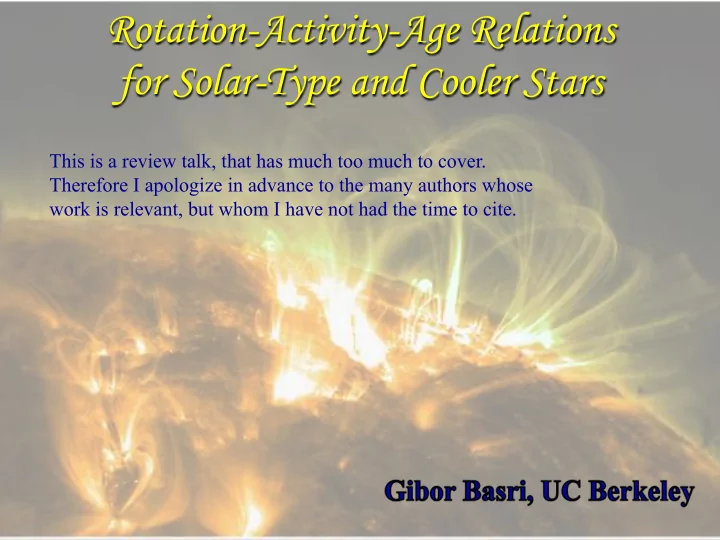

Rotation-Activity-Age Relations for Solar-Type and Cooler Stars This is a review talk, that has much too much to cover. Therefore I apologize in advance to the many authors whose work is relevant, but whom I have not had the time to cite.
The Beginning (1963): Olin Wilson sees a connection between “activity” and age
The Next Step (1967):Bob Kraft sees a connection between rotation and age (and convection zone depth)
Skumanich (1972) writes a killer (>1000 cites) 2-pager suggesting a functional form for the braking
Noyes et al. (1984) suggest a “theory” for the rotation-activity connection Suggestions at CS19 this is not right… Variables calibrated to effective temperature “Pure” stellar variables: on both axes Surface flux; Rotation period
4) The mixing length used to The variables in this “classic” compute convective turnover can be adjusted to reduce the rotation-activity connection scatter 1)The “S-index gives the amount of CaII emission relative to 3) One can calculate a the continuum convective turnover time at an “appropriate” depth using mixing-length theory = 1 2) R HK converts S to a flux, = 2 then normalizes by the effective temperature. R’ HK further subtracts a photospheric contribution.
Modernizing the Rotation-Activity connection Much larger samples of stars have their rotation periods (or velocities) determined and their “activity” (excess emission over photospheric) measured. There are activity diagnostics that are much less confused by photospheric corrections, such as X-rays. It has separately been determined that all these diagnostics correlate well with each other, and with surface magnetic fields. Here is an example from Pizzolato et al. (2003), who re-calibrated the empirical Rossby number to work well with X-rays… all cool stars They point out the empirical turnover correction is proportional to L bol 1/2 , which “suggests that for stars in the non-saturated regime [the P rot and R o ] relationships are equivalent. On the other hand for saturated stars, L x is only related to P rot …there is no need to invoke a Rossby number.”
…Rossby, or not Rossby (redux) Reiners et al. (2014) revisited the Pizzolato analysis with a sample of 821 stars with rotation periods (early M to late F). They consider relations using power law dependences on R* and P rot and find that it is difficult to say whether the use of Rossby number is superior to just using surface flux and rotation period to explain the rotation-activity connection. Alternate conclusion: magnetic surface flux only depends on rotation . This is why planets in the habitable zones of M dwarfs are subjected to high UV fluxes.
This finally breaks down for very cool stars… In early M dwarfs, saturation still applies; slow rotators are not well sampled James et al. (2000) Reiners et al. (2012) In very cool stars, there is clearly a diminution of the magnetic braking; in L and T dwarfs it is essentially gone (and the rotation periods remain as fast as hours (like giant planets) but without the large “activity” emission that would normally go with such rapid rotation.
Coming back to the Age-Activity relation… Soderblom et al. (1991) used clusters to try to calibrate CaII emission against age, and find the “Vaughn-Preston gap again: a surfeit of young active stars. This can be understood as the presence of saturation above a certain level of activity (or before a certain age).
The technique of Gyrochronology Sidney Barnes calls saturated and transitioning stars “C” type, and the older ones “I” type. He applies a Skumanich correction to P, then refines from there. * = Mt. Wilson stars The main improvement here is a more careful accounting for the dependence of the rotation-activity relation on stellar mass (with color as its proxy).
The relations are then refined for the “usual suspects” Mamajek and Hillenbrand (2006) revisit both the CaII and X-ray calibrations, and re-do Barnes’ analysis to provide what we can learn from essentially the same stars that Skumanich used (with updated and enlarged samples). [They also try to calibrate the “C” branch.]
Then along comes Kepler (and K2)! Kepler enabled the measurements of periods in stars belonging to clusters that fill in the gap between the Hyades and the Sun. Meibom et al. (2009, 2011, 2015) have shown the gyrochronology surface that relates period with age and color. Since period is also related to activity, mass and age relate directly to NGC 6811 rotation and activity in a known way . Barnes et al. 2016 M67
…and why does all this work (physically)? u The stellar magnetic dynamo depends on the rotation of the star u Angular momentum losses depend on the magnetic field u As the star brakes, the magnetic field weakens u Together these produce the Skumanich law u The emission diagnostics of chromospheric and coronal activity depend on the magnetic field (with various exponents) u The magnetic field depends on some convective property, or surface flux depends only on rotation u Together these produce the rotation-activity connection u An issue not yet fully considered: the field geometry (fraction closed or open)
This conference has shown how rich the subject is, and what progress is possible u K2 data will resolve the behavior of the active (C) branch of stars in young clusters and add cluster calibrations u New data on behavior of M dwarfs of different masses and ages u Magnetic maps and wind modeling will help illuminate what role magnetic configurations play in angular momentum loss u Data on old field stars with asteroseismic ages can help us understand what happens at old ages u More data on rotational evolution and magnetic fields for very young stars u New data on rotation-activity connection using photometry
Thank You!
Recommend
More recommend